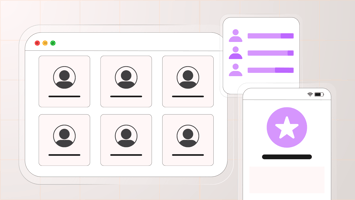The End of Lazy Loyalty
Introduction
In 2025, we believe that an impersonal loyalty program is worse than no loyalty program.
Since we merged with Repeat in 2024, we’ve been investigating how personalization impacts retention performance. In our weekly newsletter, we discovered how small tweaks can have a major impact—like switching from dollar-based to percentage-based discounts. Our top performing customers treat their loyalty program like they would any other marketing program: it’s highly customized, tested, and optimized.
If you aren't proactive with your loyalty program, it can become cannibalistic, stealing margin away from transactions that would have happened anyway.
We’re on a mission to put an end to these sorts of loyalty programs. It's what we like to call "lazy" loyalty: set-it-and-forget-it, hidden behind an on-site login, and rarely promoted in marketing channels.
If loyalty hasn't been one of your top priorities, your program likely has room for enhancement. With the right strategies, you can turn loyalty into a viable way to boost LTV and repurchase rates. But first, we'll show you what lazy loyalty looks like—and what you can do to fix it.
What is lazy loyalty?
Lazy loyalty is…
A successful loyalty program goes beyond the basics. It requires thoughtful personalization, clear objectives, and consistent optimization to drive customer engagement and retention.
If your loyalty program is operating on default settings and not being consistently optimized, you are putting yourself at a major disadvantage. While an out-of-the-box program can set you in the right direction, your program will never reach its full potential without personalization.
There’s no such thing as a 'one-size-fits-all' loyalty program. When designing your program, you need to consider what your specific customer base truly wants. This will vary based on factors like your product mix, industry, customer repurchase rate, and other retention tactics (e.g. subscriptions and discounting). With the right personalization strategies, you can strengthen your customers’ emotional connection to your brand and craft a story they’ll want to be part of.
But it's not only about what your customers want—it's just as important to figure out what you want from your loyalty program. Your strategy can wildly differ depending on which metrics you're looking to improve. For example, if you're looking to improve customer retention and 90-day repurchase rates, you might consider offering a free item as a loyalty reward. If you're looking to boost AOV, we've found that percentage-based discounts are the best offering. You need to balance customer behavior with your business needs, so it is important to develop an incentive program that accomplishes both of these things.
Of course, none of this means anything if you don't put effort into marketing your loyalty program. If a customer doesn't even know that they have points to redeem, how can you expect it to influence their behavior in any positive way? You can't, and that's why you need to integrate your program offers and rewards into the channels that you use to reach customers. For example, you can let customers know when they’ve reached a new VIP tier or if their reward points are about to expire.
We recommend replicating your on-site programs in-channel to create a delightful and consistent customer experience that drives more purchases, revenue, and retention. A brand’s website strategy and email strategy don’t always align, which can be potentially confusing for customers. Loyalty programs shouldn’t just live on your website. That’s the easiest way to lose out on potential revenue and undercut your margins. They need to be in your customers’ inboxes, too.
While personalization and marketing are key to boosting the performance of your loyalty program, you must remain vigilant when it comes to monitoring and optimizing. As we mentioned previously, every brand is different, which means there isn't a singular solution that will make every program work perfectly. Using our Analytics Dashboard, you can easily stay in touch with the health of your program. Even if you're happy with the numbers you're seeing, we recommend running frequent experiments to see if there are ways to increase performance (e.g. adding a banner to weekly sends with point balance variables).
An optimized and well-maintained loyalty program will actively drive higher retention, increase AOV, and turn one-time buyers into lifelong brand advocates.
Lazy loyalty isn’t…
Now that we know what lazy loyalty looks like, let’s set the record straight on a few things that might be mistaken for lazy loyalty.
Simple loyalty is not lazy loyalty; in fact, sometimes, a simple program might be exactly what your brand needs. If it makes sense for your brand, you can consider limiting certain aspects of your program like earning rules or VIP tiers. Too many moving pieces can make the program overly complicated and difficult to manage.
Likewise, you can keep your marketing strategy simple if you know that certain channels or segments will work better for you. Instead of spreading yourself too thin (and possibly making your messaging more generic in the process), you can target select groups with hyper-personalized marketing. Just remember this: If your loyalty program is going to thrive, it must live in-channel to make the discovery process easier for your customers. Far too often, programs are buried somewhere on-site, making it virtually impossible for customers to find them.
Keep in mind that your loyalty program might not require any changes—for now, at least. What's important is that you know what to look for when you're evaluating the performance of your program.
Why is lazy loyalty bad for business?
It cuts into your margins
When a program isn't promoted well, a customer's AOV and basket size is likely to be unaffected by any reward offer. That means you're giving away margin without getting anything in return for it.
However, with strong marketing and the right discount offers, you can start to generate some serious growth—and get something back for the margin that you're sacrificing.
After PEScience adjusted their loyalty program based on Stamped's studies, which found that percentage-based rewards led to greater lifts in AOV and basket size than any other reward type, they drove a 45% lift in AOV and a 10% lift in basket size.
Before the change, they were sacrificing tons of margin just to encourage customers to shop DTC instead of on Amazon. Now, they’re able to save 20% in margin on each order. For them, reward redemption is the price of protecting margin.
It reduces customer spending over time
A lot of brands might not realize that they are over-discounting within their loyalty programs. Over time, though, this over-discounting can damage both margin and share of wallet.
In a newsletter from 2024, we explored if VIP tiers can delay the flattening of cumulative revenue per customer. The answer was “Yes,” however, we also found a disparity between purchase frequency improvement and customer revenue improvement. In other words, while VIP tiers were driving high rates of new purchases, they were also driving less revenue.
With this information, we determined that VIP rewards can be more generous for customers than necessary. When customers take advantage of over-discounting, they might make more purchases, but the margin on those purchases is ultimately going to hurt your brand. It’s extremely important to monitor how extra rewards influence behavior among those who use them.
It damages your brand reputation
Loyalty programs are designed to enhance the customer experience and allow them to build stronger connections with your brand. If the program is difficult to use, or doesn’t deliver perceived value, it can lead to confusion or frustration, ultimately driving customers away.
A poor experience can also make customers feel undervalued or deceived, erasing any trust that they had for that brand. Also, if rewards are hard to earn or redeem, customers might feel the program isn’t worth their time or money.
It shouldn’t be a customer’s responsibility to figure out how your program works. In-channel marketing and on-site promotion should make the process self-explanatory.
Not only are customers who have a poor experience with a loyalty program less likely to interact with the program—they’re less likely to ever buy from your business again.
How do I avoid falling into the lazy loyalty trap?
Over the next several weeks, we'll be diving into different ways you can improve the health of your loyalty program in 2025. This includes a benchmarking report, a library of Plays that will help get your program into shape, and a performance calculator to better understand the health status of your program.
Also, you can subscribe to the Stamped Saturday Email for exclusive insights on how brands can overcome lazy loyalty.
Ready to get your program back into shape? Book a demo with our team and learn how Stamped can help you drive AOV, customer retention, and more with loyalty.
-1.jpg?width=50&name=Aiden_Brady.tif-664x900%20(1)-1.jpg)

%20(3).png?height=200&name=10%20Ecommerce%20Trends%20Redefining%20Your%20Marketing%20Strategy%20in%202024%20(and%20Beyond)%20(3).png)
